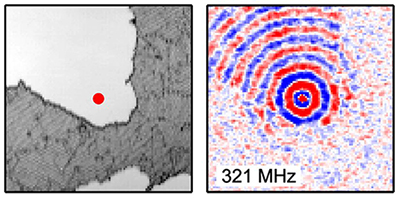
See also the layperson's introduction: Jumping frogs, squeaking bats and tapping woodpeckers and Watching ripples on crystals.
In collaboration with coworkers in France and the USA, we have imaged very high frequency ripples as they cross a glass surface coated with microscopic silica beads. Each bead can vibrate, as if attached to the glass with tiny springs, at frequencies up to around 1 gigahertz (=109 cycles/s). This sort of composite structure is called an acoustic metamaterial.
Acoustic metamaterials are interesting because they exhibit counterintuitive properties such as negative density, and can be used to block sound, for example. By making movies of waves on an acoustic metamaterial, we can characterize them very accurately, and watch the waves being transmitted at boundaries between parts of the sample with and without the bead metamaterial.
The figure belows shows an image of part of our metamaterial obtained with an optical microscope, together with a model that treats the beads as masses on springs.

Left: optical microscope image of the sample consisting of 1 micron diameter silica beads on a glass substrate. Right: model that describes the metamaterial surface vibrations.
Using ultrafast laser techniques, we can watch the ripples transmit into the metamaterial from a region outside at specific frequencies. We find that at certain frequencies the ripples do not transmit well because they are disturbed by the vibrations of the beads, as in the example shown below.

Left: optical microscope image of a 100 micron × 100 micron region with and without beads. The red spot shows where we excite the acoustic waves outside the metamaterial region. Right: surface acoustic wave image at a frequency of 321 MHz. The waves cannot penetrate the metamaterial at this frequency.
We also analysed the ripples inside the metamaterial region to find their propagation characteristics, and developed a theoretical model to explain our results. Full details can be found in
'Time-domain imaging of gigahertz surface waves on an acoustic metamaterial,' P. Otsuka et al., New J. Phys. 20, 013026 (2018) .